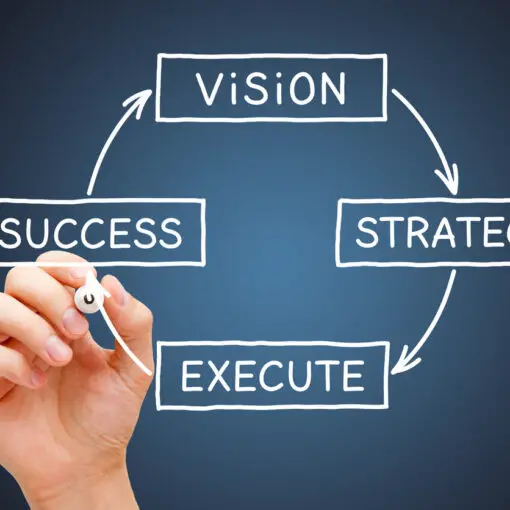Strategic thinking and strategic planning are essential components of an organization’s success, but they are not the same. Understanding the differences between these two concepts can help leaders more effectively address the challenges their organizations face. Both processes require vision, creative problem-solving, and an understanding of the organization’s goals, but they approach these tasks differently.
Strategic thinking is a continuous, high-level activity focused on developing an organization’s strategic vision and goals. It involves using creative skills to find innovative solutions to business challenges and identify new opportunities for growth. On the other hand, strategic planning is a more specific, detailed process that involves creating an action plan to achieve these goals and ensuring alignment between the organization’s resources and objectives.
While strategic planning typically focuses on a specific project or effort, strategic thinking is an ongoing endeavor that informs every aspect of an organization’s operations. By nurturing both strategic thinking and planning, organizations can more effectively adapt to changing market conditions and maintain a strong competitive advantage.
Strategic Thinking vs Strategic Planning
Strategic thinking and strategic planning are two essential components of business success. They share some common goals, such as setting priorities and defining a clear path to achieve those objectives. However, there are distinct differences between the two concepts.
Strategic Thinking
Strategic thinking is an ongoing, proactive mental process that focuses on the generation of innovative ideas and goals. It encourages creativity and a broader perspective, allowing individuals to develop unique solutions for common business challenges. Strategic thinking can be a nurtured attribute and is not limited to specific projects or efforts. It is applicable across all levels and functions within an organization, enabling employees to contribute to the organization’s success constantly.
Strategic Planning
In contrast, strategic planning is a structured process that defines tactical actions to achieve the organization’s goals. It involves data gathering, analysis, and decision-making on the path the business will take. Strategic planning differs from strategic thinking in that it is fixed to specific projects or efforts, and it requires specific skills to be conducted efficiently.
| Strategic Thinking | Strategic Planning |
|---|---|
| Ongoing, proactive mental process | Structured, goal-oriented process |
| Encourages creativity | Involves data gathering and analysis |
| Applicable across all levels | Fixed to specific projects or efforts |
| Focuses on generating new ideas | Focuses on defining tactical actions |
To summarize, strategic thinking and strategic planning serve distinct purposes in an organization’s success. While strategic thinking focuses on generating innovative ideas, strategic planning is a structured process that defines the steps required to achieve the organization’s goals. Both components must work together to ensure a successful and sustainable business landscape.
Defining Strategic Thinking and Strategic Planning
Definition of Strategic Thinking
Strategic thinking is a mindset or cognitive process that involves analyzing complex situations, identifying underlying problems, and developing a long-term plan of action to address these issues. It requires individuals to use their creative skills and come up with innovative ideas or goals that contribute to the success of an organization 1.
Key aspects of strategic thinking include:
- Creativity: Generating new ideas and approaches to tackle problems
- Analysis: Assessing situations and determining underlying issues
- Problem-solving: Finding unique solutions to common business challenges
- Long-term focus: Setting achievable goals with an eye on the future
Definition of Strategic Planning
On the other hand, strategic planning is a structured process that deals with the tactical actions needed to achieve the organization’s vision as informed by strategic thinking 2. In strategic planning, leaders gather data and decide on the path the organization will take to reach its goals 3. Unlike strategic thinking, strategic planning is more focused on the specific steps and resources required to accomplish the objectives.
Key elements of strategic planning involve:
- Data collection: Gathering relevant information and insights to inform decision-making
- Goal setting: Defining clear and measurable objectives based on the organization’s vision
- Resource allocation: Assigning the necessary assets and manpower to execute the plan
- Monitoring progress: Frequently assessing the progress and making adjustments as needed
In summary, strategic thinking is a creative and analytical process revolving around problem-solving and long-term vision, while strategic planning is a structured approach focusing on the tactical actions required to achieve organizational goals. Both concepts play vital roles in the success of any organization.
Skills and Abilities Involved
Strategic Thinking Skills
Strategic thinking involves the development of an organization’s vision and goals. It often requires creativity and innovation to find unique solutions to common business challenges or establish new ways to achieve objectives.
Some essential skills for strategic thinking include:
- Problem-solving: Identifying obstacles and generating ideas to overcome them
- Decision making: Analyzing available information to make informed choices
- Critical thinking: Evaluating the feasibility of ideas or approaches
- Creativity: Generating new and innovative concepts to address challenges
These skills collectively allow individuals to foresee possible future scenarios and adapt their strategies accordingly.
Strategic Planning Skills
While strategic thinking is more abstract, strategic planning refers to the specific, detailed process of creating an action plan to achieve the organization’s goals. The focus here is on developing clear objectives, assigning resources, and monitoring progress to ensure a successful outcome.
Key skills needed for strategic planning include:
- Project management: Organizing and guiding the execution of plans
- Data analysis: Gathering and interpreting information to make informed decisions
- Communication: Effectively conveying the plan and its objectives to stakeholders
- Resource allocation: Ensuring the right assets are in place to achieve the organization’s goals
By employing both strategic thinking and planning skills, professionals can create a well-rounded approach to achieving their organization’s objectives. These abilities, when used in tandem, provide a solid foundation for strategic management and overall success.
Role in Organizational Success
Communication and Leadership
Strategic thinking and strategic planning both play crucial roles in an organization’s success. They serve different purposes but are interconnected in many ways. One of the significant differences between the two is the way they involve communication and leadership.
In strategic thinking, employees at all levels and in all functions continually scan for new ways to contribute to the organization’s success. This requires open communication channels between individuals and departments. Additionally, strategic thinking encourages innovation and creative solutions, and as such, leaders should foster a supportive environment that values diverse perspectives and promotes a culture of curiosity.
On the other hand, strategic planning typically involves more top-down communication, as senior leaders gather data and decide which path the organization will take to achieve its goals. In this case, effective leadership ensures that strategic plans are communicated clearly to staff members and aligned with their roles and responsibilities. This ensures that everyone is working towards shared organizational goals.
Effectiveness and Productivity
Both strategic thinking and strategic planning impact organizational effectiveness and productivity, but they do so in different ways. Strategic thinking is more about generating innovative ideas and setting the long-term direction for the organization. It involves identifying opportunities, assessing risks, and evaluating the competitive landscape. When employees engage in strategic thinking, they develop a deeper understanding of the organization’s purpose and objectives, leading to increased commitment and motivation. This can, in turn, contribute to higher productivity.
In contrast, strategic planning focuses on creating detailed action plans to achieve the organization’s goals. A well-executed strategic plan can improve organizational performance by ensuring that resources are allocated effectively and tasks are prioritized appropriately. Moreover, a clear strategic plan offers a roadmap for employees to follow, reducing uncertainty and increasing efficiency.
To summarize, while strategic thinking and strategic planning serve different purposes, they are both vital components in driving an organization’s success. By fostering open communication, effective leadership, and a culture of innovation, organizations can maximize their effectiveness and productivity.
The Processes
In this section, we will explore the processes involved in both strategic thinking and strategic planning. These processes are essential for creating a solid foundation for an organization’s growth, direction, and success.
Process of Strategic Thinking
Strategic thinking is a mindset or cognitive process that involves analyzing complex situations, identifying underlying problems, and developing a long-term plan of action to address them. It requires individuals and teams to think creatively and critically about the challenges and opportunities their organization faces.
The process of strategic thinking typically involves the following activities:
- Analysis: Examine the current situation, assess internal strengths and weaknesses, and evaluate external opportunities and threats. This can include SWOT, PESTLE, or other analytical tools.
- Scenario Planning: Develop multiple scenarios of potential future outcomes and plan for how the organization would respond in each situation.
- Creativity and Innovation: Generate new ideas or alternative approaches to address challenges and capitalize on opportunities.
- Synthesis: Combine insights from the above activities to create a comprehensive understanding of the organization’s goals, challenges, and opportunities.
- Decision Making: Make decisions and set priorities based on the synthesized analysis to achieve the organization’s long-term objectives.
Process of Strategic Planning
Strategic planning, on the other hand, is a structured process that translates an organization’s strategic thinking into actionable goals and initiatives. It involves establishing a clear direction, setting specific objectives, and developing a roadmap to achieve them. The strategic planning process generally follows these steps:
- Set Direction: Determine the organization’s purpose, vision, mission, and core values.
- Develop Goals and Objectives: Identify specific, measurable, achievable, realistic, and time-bound (SMART) goals and objectives that align with the organization’s direction.
- Create Strategies: Develop high-level strategies that outline how the organization will achieve its goals and objectives.
- Action Planning: Break down strategies into prioritized activities, assignments, and timelines for execution.
- Resource Allocation: Assign necessary resources, including personnel, finances, and tools, to support the implementation of the action plan.
- Monitoring and Evaluation: Track progress, measure performance against objectives, make adjustments as needed, and continuously improve.
Both strategic thinking and strategic planning play crucial roles in shaping an organization’s future and determining its success. Strategic thinking generates creative and innovative solutions, while strategic planning provides a structured approach to implementing those solutions and achieving desired outcomes. Understanding the processes involved in each can help organizations navigate the ever-changing business landscape with clarity and confidence.
Strategic Vision and Direction
The foundation of both strategic thinking and strategic planning lies in setting a clear and compelling vision for the organization. A well-defined vision helps in identifying long-term goals and establishing a roadmap to guide the company’s direction.
Vision for the Organization
A clear vision statement drives an organization forward by providing a unified sense of purpose. It outlines the organization’s aspirations and creates a mental image of what success will look like. The vision should be actionable, inspiring, and capable of rallying employees and stakeholders towards achieving common goals. An effective vision statement can be instrumental in establishing the organization’s competitive advantage in the market.
Competitive Advantage
One of the key aspects of strategic vision and direction is identifying and leveraging the organization’s competitive advantage. This requires understanding the company’s unique value proposition and differentiators that set it apart from competitors. In strategic thinking, individuals explore innovative ways to create new competitive advantages. In strategic planning, the focus is on how to maintain and expand existing competitive advantages.
Long-Term and Short-Term Goals
Both strategic thinking and strategic planning involve setting long-term and short-term goals that align with the organization’s vision. These goals serve as milestones on the path to achieving the organization’s overall objectives.
- Long-term goals: These are broader, overarching targets that usually span years or even decades. They are closely tied to the organization’s vision and often reflect the company’s desired position in the industry, market share, or financial performance. Long-term goals guide the direction of strategic initiatives and provide a foundation for strategic planning.
- Short-term goals: These are more immediate, tactical objectives, typically achieved within a year or a few months. Short-term goals support the attainment of long-term goals by breaking them down into manageable tasks. They are more focused on specific actions and operational activities within the organization.
In summary, a coherent strategic vision and direction are essential for guiding an organization towards its long-term objectives. Identifying a clear vision, creating competitive advantages, and setting appropriate long-term and short-term goals play crucial roles in achieving success in both strategic thinking and strategic planning.
Innovation and Creativity
Innovation and creativity play crucial roles in distinguishing strategic thinking from strategic planning. While strategic planning involves gathering data and deciding the organization’s path to achieve its goals, strategic thinking encourages employees at all levels to continually scan for new ways to contribute to the organization’s success1.
Innovation and creativity are often complementary in nature. Creativity involves original thought and knowledge, which unleashes potential and is an integral part of idea generation4. Meanwhile, innovation is used to turn the creative ideas into viable solutions4. Both are necessary for driving a company’s growth and success.
One approach to fostering innovation and creativity in a strategic context is embracing the concept of “strategic creativity” and “creative strategy”5. This symbiotic interplay between strategic and creative thinking allows organizations to tackle complex problems effectively and design innovative solutions.
Some ways to develop strategic thinking skills which include innovation and creativity are:
- Gaining exposure to strategic roles3.
- Synthesizing broad information3.
- Participating in a culture of curiosity3.
- Gathering experiences that allow for creative and innovative thinking3.
By incorporating innovation and creative abilities into strategic thinking, employees can not only identify opportunities but also come up with innovative ideas to drive their organizations forward.
Goal Setting and Objective Length
When approaching strategic thinking and strategic planning, it is essential to understand the concepts of goal setting and objective length to create a clear and actionable plan.
Setting goals is a crucial part of both processes. However, the type and length of objectives can vary based on the chosen approach.
In strategic thinking, individuals and organizations typically set long-term goals, which can last anywhere from a few months to several years, depending on the complexity of the objective they set. Long-term goals are often larger goals that can be worked towards by building smaller plans to achieve them 1.
On the other hand, strategic planning focuses on defining short-term goals that serve as stepping stones to achieving broader, long-term objectives. These goals are more measurable and typically have a shorter timeline or a specific project attached to them 2.
Here’s a summary of the key differences in goal-setting based on the chosen approach:
| Approach | Goal Type | Objective Length | Example |
|---|---|---|---|
| Strategic Thinking | Long-term goals | Months to several years | Increasing overall market share by 20% over five years |
| Strategic Planning | Short-term goals | Weeks to a few months | Launching a new product within the next quarter |
When setting goals, it is important to ensure that they are measurable, relevant to the organizational context, and align with the desired overall direction 3. This is especially important when setting long-term goals in strategic thinking, as they set the foundation for the overall direction of the organization. Short-term goals in strategic planning, on the other hand, need to be more specific and actionable, as they contribute to achieving the larger, long-term objectives.
Overall, understanding the differences in goal setting and objective length for strategic thinking and strategic planning helps organizations effectively develop strategies, make informed decisions, and navigate complex environments with greater success.
Proactivity and Reactive Change
In the context of strategic thinking and strategic planning, proactivity plays a crucial role in navigating an organization through change. A proactive approach allows leaders and their teams to anticipate potential obstacles and devise plans to overcome them before they become a problem. On the other hand, reactive change is addressing issues after they have occurred.
Strategic thinking requires a proactive mindset, where leaders consider the long-term goals and continually analyze the environment to identify growth opportunities and potential risks. This proactive approach enables leaders to make well-informed decisions and establish a flexible and robust process for change.
Some ways to promote proactivity in the strategic context include:
- Identifying core values and organizational purpose for clarity and guidance
- Continuously analyzing the environment and conducting SWOT analysis
- Encouraging innovation and creative problem-solving
- Engaging in constant communication and collaboration with various stakeholders
In comparison, strategic planning is a more structured process that translates the organization’s vision into actionable plans. While strategic planning is also proactive, leaning more towards tactical implementation, it may sometimes require reactive change when unforeseen obstacles arise.
Reactive change is necessary when an organization experiences unexpected events or issues that weren’t addressed during the planning process. In such cases, adapting to this change can be critical for the organization’s success. However, an over-reliance on reactive strategy can lead to inefficiencies and missed opportunities.
To strike a balance between proactivity and reactive change, organizations should:
- Align their strategic planning process with proactive strategic thinking
- Develop contingency plans to address potential risks
- Continuously monitor and evaluate the outcomes of strategic initiatives
- Encourage a culture of learning and adaptability to respond to change effectively
In conclusion, the ideal approach to strategic thinking and planning involves proactivity and the ability to respond to reactive change when necessary. By incorporating both, organizations can reap the benefits of foresight and adaptability, leading to successful navigation through change and growth opportunities.
Careers and Professional Development
Strategic Thinking Career Paths
Strategic thinking is a vital skill for professionals seeking to excel and innovate in many career paths. This skill enables individuals to generate creative solutions and shape growth-oriented strategies for their organizations. Some popular careers involving strategic thinking include:
- CEO
- General Manager
- Product Manager
- Business Consultant
- Marketing Strategist
These professionals are not limited to a specific industry, as their skills are transferable among various sectors.
Strategic Planning Career Paths
Strategic planning, on the other hand, focuses on creating and implementing action plans to achieve specific goals. The skill is used in roles that require a systematic approach to managing projects and driving business initiatives. Common career paths that involve strategic planning include:
- Strategic Planner
- Project Manager
- Operations Manager
- Financial Analyst
- Supply Chain Manager
Similar to strategic thinking, these roles are not confined to any particular industry, which offers greater flexibility and control in shaping one’s career.
Certifications and Training
For individuals seeking to advance their careers and become thought-leaders in strategic thinking or planning, earning relevant certifications can be beneficial. Many professional development programs and courses can equip individuals with these skills. Some noteworthy certifications and training include:
- Strategic Thinking
- Certificate in Business Strategy from Harvard Business School Online
- Design Thinking Certification Program from IDEO U
- Creative Strategy and the Business of Design Course from LinkedIn Learning
- Strategic Planning
- Project Management Professional (PMP) by Project Management Institute
- Agile Certified Practitioner (ACP) by Project Management Institute
- Supply Chain Professional (CSCP) by APICS
Pursuing these certifications and training opportunities can not only enhance one’s skill set but also increase their potential for promotions and career growth in their respective fields.
Tools and Techniques for Efficient Planning
Efficient planning is critical to the success of any strategic initiative. This section will discuss tools and techniques for effective planning, with a focus on project management skills and strategies.
Project Management Skills
Effective project management skills are essential for efficient planning. Key skills include:
- Communication: Clearly conveying goals, tasks, and updates to team members
- Time management: Effectively organizing, prioritizing, and managing tasks to meet deadlines
- Problem-solving: Identifying and addressing potential roadblocks or issues before they escalate
- Analysis and evaluation: Assessing progress and performance to make adjustments, as needed
In addition to these skills, familiarity with specific project management methodologies, such as Agile, Scrum, or Waterfall, can enhance your strategic planning efforts.
Strategies
Implementing the following strategies can help improve the efficiency of your planning process:
- Clearly define objectives: Before you begin any planning process, ensure that your objectives are clearly defined and understood by all team members.
- Break down tasks: When dealing with complex projects, break them down into smaller, more manageable tasks or Milestones.
- Use tools for organization: A variety of tools can assist in efficient planning. These may include Gantt charts, Kanban boards, and more.
- Prioritize tasks: When faced with a daunting to-do list, prioritize tasks based on their urgency, importance, and level of effort.
- Establish clear roles and responsibilities: Assign tasks to team members, considering their capabilities and availability.
- Monitor and adjust: Regularly track progress, evaluate performance, and make adjustments as needed.
To-Do List and Due Dates
A well-structured to-do list can be an invaluable tool for efficient planning. To maximize its effectiveness:
- Clearly identify tasks.
- Assign a due date for each task.
- Group tasks based on priority or function.
- Use updates or reminders to stay on track.
By applying these tools and techniques for efficient planning, you can improve your project management skills and enhance your strategic thinking and planning efforts. Remember that regular monitoring and adaptation are key to success in strategic planning.
Footnotes
- (https://www.indeed.com/career-advice/career-development/strategic-thinking-vs-planning) ↩ ↩2 ↩3
- (https://www.aha.io/blog/strategic-thinking-vs-strategic-planning) ↩ ↩2
- (https://www.harvardbusiness.org/strategic-thinking-because-good-ideas-can-come-from-anywhere/) ↩ ↩2 ↩3 ↩4 ↩5 ↩6
- https://online.stanford.edu/creativity-and-innovation-management ↩ ↩2
- https://ideadrop.co/innovation-strategy/creative-vs-strategic-thinking-whats-difference/ ↩





